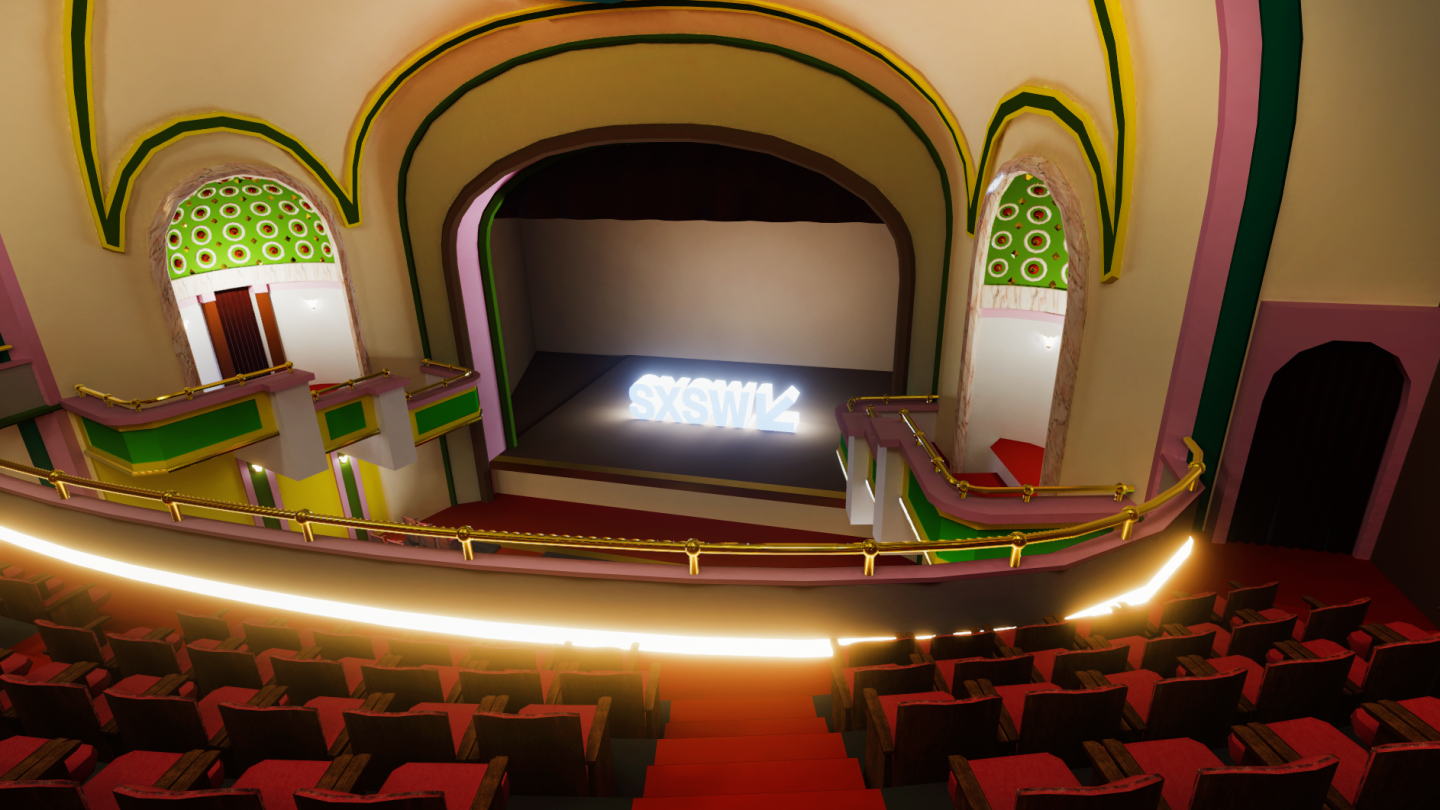
By now you know the drill: the global pandemic rolls into its second year of chasing all major events online. Which means everyone who is attending is doing so from their living rooms. This is our running diary of No Proscenium’s Noah Nelson and Kathryn Yu’s experience of SXSW 2021, with our focus on all things immersive & experiential. — Noah Nelson, Publisher
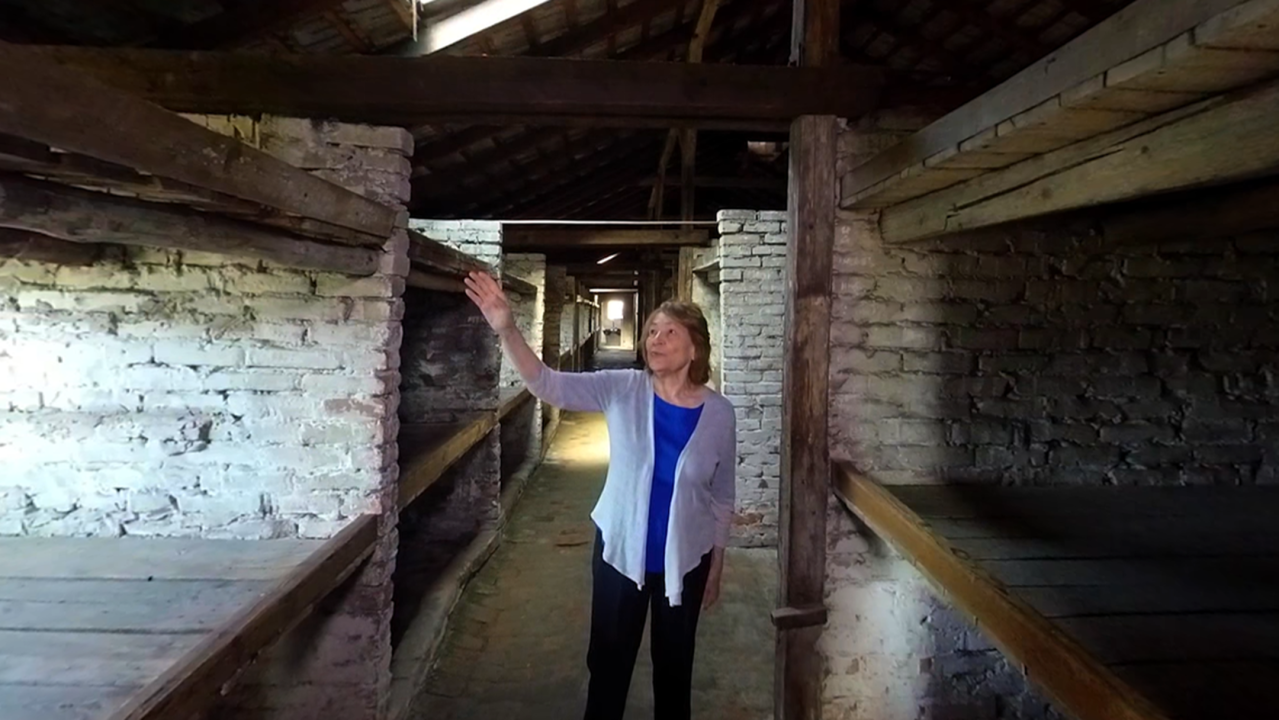
A Promise Kept — Kathryn Yu
In this chilling VR documentary, Holocaust survivor Fritzie Fritzshall returns to Auschwitz and speaks not only about her experiences both there but also about her time working as forced labor for the Nazis during the war. The film is harrowing, to be sure, as the now aged Fritzshall walks through gas chambers, latrines, and barracks — the same barracks she once lived in as a child before being shipped off to work at a factory. She describes in shocking detail exactly what life was like for her at Auschwitz as we move through these horrific spaces.
We the viewers also eventually learn who saved her life after she left Auschwitz: the 599 other female factory workers who collectively sacrificed enough food for Fritzshall to eat. In turn, the young girl promised that if she survived, she would tell their story.
And now she has, to the entire world. (3/19/21)

Before Your Eyes — Kathryn Yu
This beautiful interactive narrative is, from what I can tell, the only one in competition that isn’t in virtual reality. It’s a downloadable first person POV narrative PC game about reliving memories of your life after death which uses a unique blink mechanic. The game turns on your webcam and after a brief calibration session, allows you to progress through the game by blinking to travel through time: starting from infancy to childhood and then onto independence and adulthood. On occasion, a metronome will also appear and the scene will continue without pause until you’ve blinked in front of the webcam — meaning you might only get bits and pieces of dialogue and a character may be interrupted mid-sentence. And at specific decision points, you can also control what happens next in Before Your Eyes by pointing your mouse cursor at certain targets (shown in-game using “eye” icons) and blinking your eyes at that same camera.
The visuals of the game are well-crafted, distinctive, and reflective of the subject matter. The scenes often have a splotchy or ambiguous start and gradually the details come into focus via animation, lending a cinematic quality to the memories. Additionally, if you move your perspective using the mouse, you’ll notice that things on the periphery may become slightly blurry or fuzzy on the screen, just like in real life. When the main character is upset, things go out of focus in the game as well, which is a very nice touch. These compelling visuals coupled with excellent writing and voice acting all fit together into a tight, cohesive storytelling package.
The original version of the game, Close Your, won awards at both IndieCade and the Independent Game Awards several years ago. The new version appearing here at SXSW is a preview of the full game, which will be released on Steam in April. Even though the preview version of Before Your Eyes only contained about three-fourths of the full game, I was sucked so deeply into the story that 90 minutes had passed before I realized I was at the end of the demo.
This experience is one to keep your “eyes” on, indeed. (3/19/21)
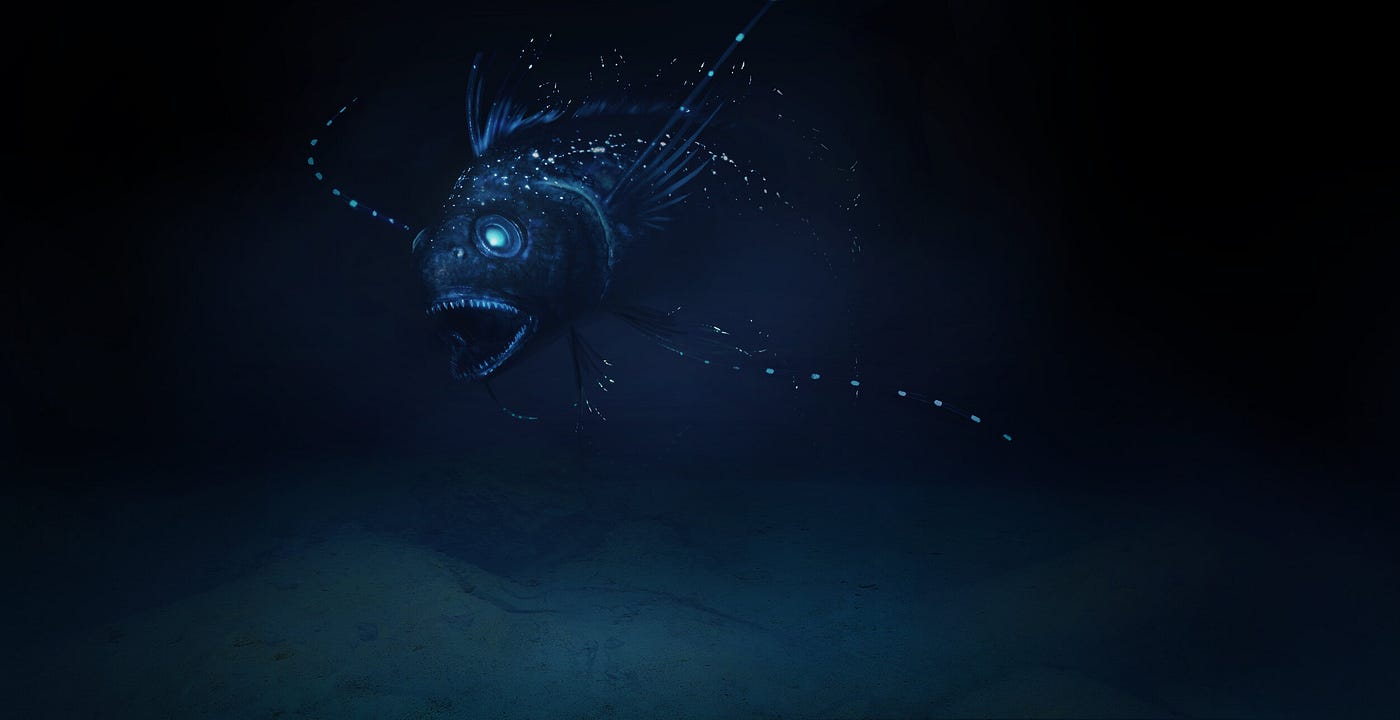
Biolum — Noah Nelson
This one is freaky to be sure, but the best thing about Biolum is how it rides the line between a passive cinematic experience and full narrative agency for the audience.
Here we are cast as Rachel (Dominique Tipper), a diver on an expedition to a heretofore unexplored deep sea ecosystem filled with biolumescent lifeforms. The first few minutes of the experience feel like a “oddities of science” follow up to *The Blu*, one of the first VR projects to gain a lot of buzz in the early days of the VR Renaissance. (The VRenaissance? No? Okay. Let’s not do that again.) Yet once Rachel gets to bantering with her handler Eva, voiced by Charlotte Rampling the fictive nature of the narrative starts to seep in.
While Biolum isn’t all that long, there is some deep, deep Sci-Fi strangeness woven in here that pays off in the narrative we’re given and makes for a good compass point for where this story or stories like it could go. What makes it all work is the drama of the script as excellently performed by Tipper and Rampling. Turns out that if you write solid characters and get good actors to tackle the material it can really push things up a notch. Who knew? ;-) (3/22/21)

(Hi)story of a Painting — Kathryn Yu
This educational VR film takes viewers into the history behind the iconic “A Sunday Afternoon on the Island of La Grande Jatte” painting by Georges Seurat. The painting itself is introduced in a blank museum room but then the walls of the museum fall away and we’re plunged into Seurat’s life. The narrator walks us through his story from his childhood to his first exhibition to how his legacy lives on today.
(Hi)story of a Painting is polished and well-executed but to me it feels like the concept doesn’t quite lean into the affordances of VR as much as I would have liked to see. For example, I pretty much ended up facing the painting the entire time as the action mainly happens in the periphery of the artwork or on either end of the bridge that we’re placed on. Before seeing this VR piece, I didn’t realize much how I didn’t know about Seurat. But I do need to say, having seen the original painting in person, nothing quite compares, even in virtual reality. (3/19/21)
Noah’s Notes
While I certainly learned a lot about Seurat’s La Grande Jatte which I didn’t know before I’m not sure that material is served well by VR as a medium. There’s nothing in here that made me glad I strapped on ye olde Oculus versus, say, clicking around on an interactive webpage.
I wish I could be more enthusiastic, but we’re past the point where the clear affordances of VR are a thing. If the work you’re making isn’t rooted in at least one those affordances — spatial relationships, user agency, dynamics of scale, the elusive ideal of “presence” — then it isn’t worth the time to render the graphics.
I mean, we’re talking about the most famous Neo-impressionist painting the one that put divisionism/pointillism on the map and we don’t play with scale to show how the effect works? A missed opportunity for sure. (3/22/21)
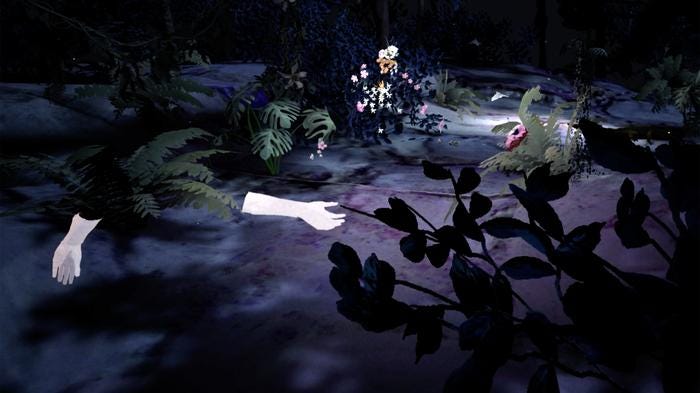
Of Hybrids and Strings — Kathryn Yu
I get major Annihilation vibes from Of Hybrids and Strings, but, like, in a totally good way. You’re placed inside a serene forest at night and facing you is your “mirror.” Kind of. It’s an avatar made out of mostly flowers in a semi-recognizable humanoid space which literally mimics your every move; raise your arm, and it raises its opposite arm. The movement is a little bit freaky at first, but also totally mesmerizing, like the piece itself. I truly wanted to reach out and touch my flower-y avatar twin, but, alas, I ended up hugging my television instead. Oops. You’re meant to be interacting from a distance but I really just wanted our close up.
As the forest changes around you, there’s long strands of white rope draped everywhere, like a giant cat’s cradle, but in virtual reality. The quiet, meditative nature of this abstract piece of art felt soothing after a long day and it was quite easy to fall under Of Hybrids and Strings’ spell. (3/18/21)
Poison — Kathryn Yu
I’m not sure I was emotionally prepared for this scientific documentary piece that uses technology to place you at the cellular level with human tissue and viruses.
Content advisory: there’s something in here that looks a lot like SARS-CoV-2 and… there’s also a bunch of people coughing in VR all around you.
I can see this as a piece like this being used quite effectively in education and museum settings, though I’m not 100% sure if I’m coming away with the right message.
Is it that viruses are fascinating? Or terrifying? Or both? Mostly, I’m impressed with the power of communicating science through VR and the sense of scale that happens when you’re shrunk to the size of a tiny virus. (3/18/21)
Noah’s Notes
Look, I get the idea of viewing our battle with Covid-19 as a war. I use some of the same framing when I try to explain why masks are still important even as we all get vaccinated. How each body we keep from getting infected is one less breeding ground for the virus.
But I’ve got zero interest in taking a virus eye view of the human body these days.
There might be something missing in the cultural transliteration between this American viewer and the Korean developers of the short, but if the goal of the project was for viewers to “feel the intelligence of the virus and its danger intuitively” this felt like a weird way to go about it. The perspective implies sympathy for the devil, but the whole thing plays out more like a propaganda reel from WWII. Pick your “other.” I’m not sure what that particular framing adds to the very real need to get people to understand how the relentless nature of a virus puts us at a collective disadvantage for beating an invisible enemy.
TL;DR: Hard nope. (3/22/21)
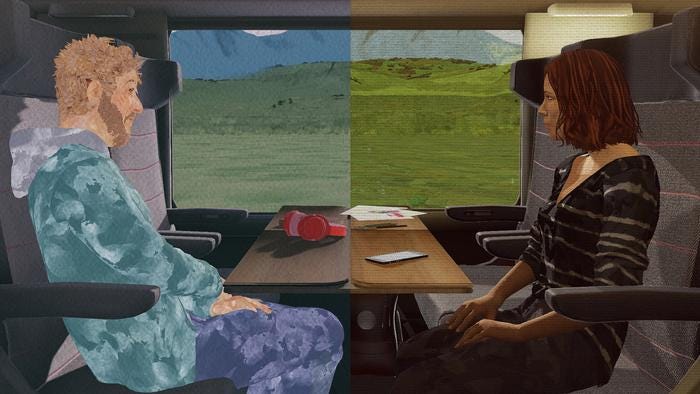
The Passengers: Her & Him — Kathryn Yu
This experimental piece flips back and forth between 360 video with interactive scenes rendered using a game engine; this may sound like a difficult technical and artistic challenge, and it is, but the segues between the two are fairly smooth, which is a feat in and of itself. They don’t feel unnatural, as you might expect. Viewers have the choice of experiencing The Passengers from one of four perspectives: four separate people who happen to be sharing a booth on a passenger train: a man, a woman, an elderly woman, and a child. They’re not traveling together and yet they are somehow thematically connected. (Of the four passengers, only two are currently available: the man and the woman.)
Get No Proscenium’s stories in your inbox
Join Medium for free to get updates from this writer.
SubscribeSubscribe
The participant experience mainly centers around looking around at the environment from the perspective of your chosen character. As you observe the other characters around you, the backend is actually triggering different internal monologue passages based upon your gaze. If you stay in the same position long enough, the interface shows a small icon of “selecting” a gaze point. The idea is that depending upon where you look, the content you receive is going to be different but the overall narrative feels like it’s still mostly on-rails. But the bulk of the experience is less about interactivity and more about observing and listening as you hear your chosen character’s inner monologue and watch flashbacks of their memories. (All the memories are clearly differentiated from the interactive portions through the use of 360 video.)
The participant is also asked to speak once in a while, though I found this tiny bit of interaction a little distracting as you might answer “yeah,” “sure,” or “OK” to a question but your character answers it slightly differently out loud with the word “yes,”leading to a mental disconnect.
Both of the two currently available characters (Her and Him) are struggling with some sort of large, looming issue in their lives (whether or not to have a child with one’s partner, or one’s inability to talk to/hit on strangers) and the participant is exposed to all of their unedited neuroses. Normally, I’m quite interested in the concept of “sonder,” that is, the realization any random passerby is living a life as vivid and complex as your own, but it doesn’t work for me here. I’m sorry to say that of these two characters, I didn’t feel an emotional connection to either of their concerns, particularly in the case of the man struggling to flirt with women he didn’t know personally.
From a technical perspective, this experience is fascinating, but from a narrative point of view, well, I felt as if I might have been better off if they’d stayed strangers. (3/18/21)
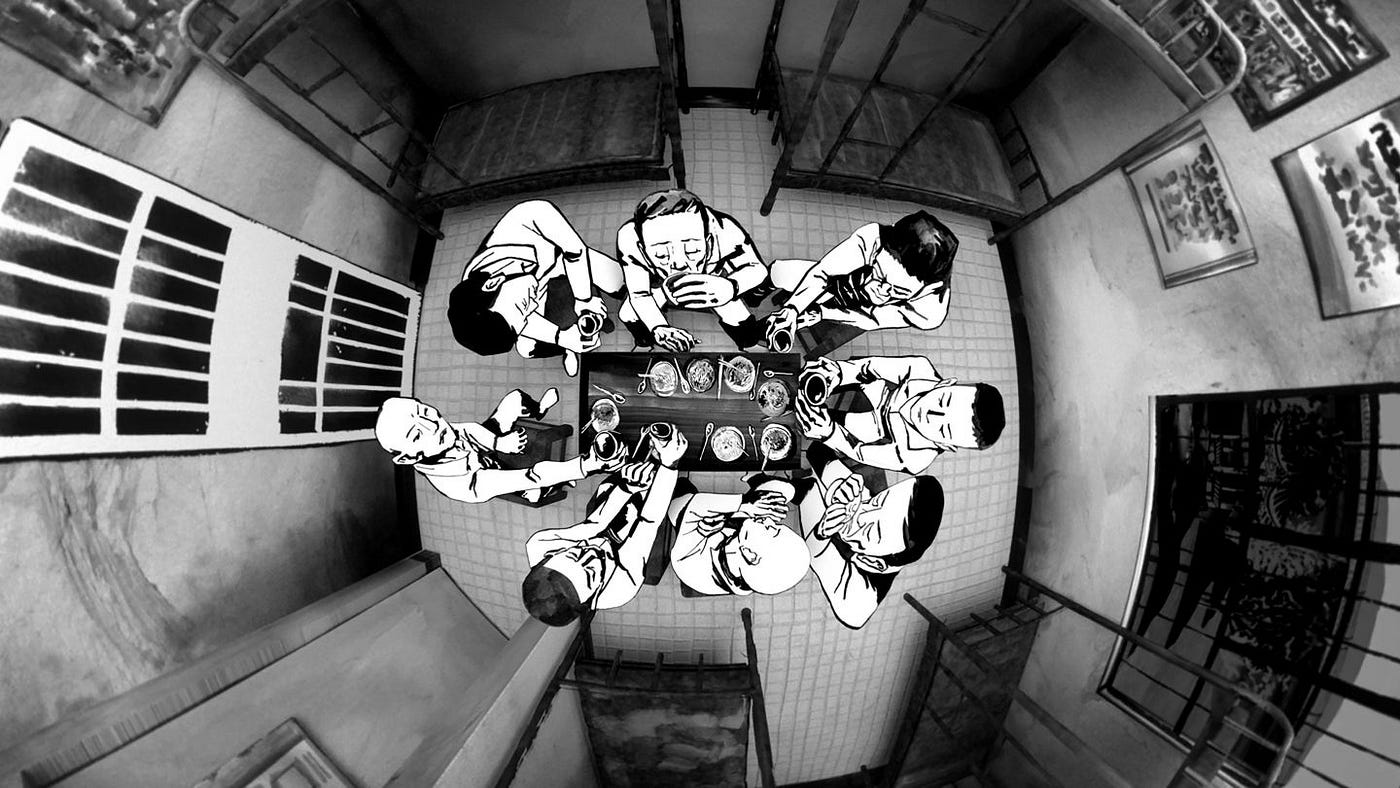
Reeducated — Kathryn Yu
Created by journalist Ben Mauk and director Sam Wolson, this moving, poignant documentary-style piece leverages illustrations and audio testimonials to paint a picture of China’s minority detention camps in Xinjiang. And when I say paint, I mean to literally bring to life using ink. We hear the story of these detainees from their first hand perspectives, tracing the moments from when they were detained to the brutal conditions of their lives behind bars and to their eventual release, months later.
The exemplary artistic skills of Matt Huynh fill out the spaces around the viewer using black and white ink as the three interviewees describe what the camps were like. The most stark moment for me was when one of the former detainees describes the tiny, crowded room in which they all slept; a chill went up my spine as nearly a dozen men were shown crowding into four bunk beds. (3/18/21)
Samsara — Kathryn Yu
It’s difficult to describe this piece without giving away too many spoilers but I’ll try: imagine a surreal dark-ride mixed in with a science fiction fantasy and a nice twist towards the end, that sets up the rest of the series (I’ll note that this is only episode one).
The creators really understand how to make the most of what VR affords us: playing with space, playing with scale, playing with camera movement. There’s a scene where I believe the creators are showing us what it’s like to be an infant with an adult hand in your face. The avatar’s fingers are enormous, unrelenting, and uncomfortably close, and, yet, the whole thing is fascinating to view as a recreation of a memory that I’d guess most of us have but cannot recall.
There are also some very dark scenes in here where the viewer is propelled through some ghastly tableaux, which led me to believe the piece was going in a direction more aligned with some nasty violence or perhaps true crime. But Samsara mixes it up: there were also a few very pretty, trippy, psychedelic moments, which also led me to think it was going in yet another direction, but it all comes together with a narrative reveal at the end. Think of this more as a prologue, one which only whets my appetite for more Samsara to come. (3/18/21)
Noah’s Notes
Kathryn does a pretty good job of breaking down the way that the team behind Samara uses VR in effective ways, and I won’t take that away from them.
However, while I love some of the trippy (it’s a theme this year) imagery is executed there are big parts of this piece that I just found mad depressing. I know that it is labeled “part one” of a series, but what’s on display made me long for something more like a vertical slice of the whole project. Especially since this is a piece where we don’t have much in the way of agency by design.
In short: I wanted to like this. I thought a good chunk of it was beautiful. But after a year of daily, intimate reminders of the mortality of myself and my loved ones, I found the whole thing emotionally oppressive. (3/22/21)
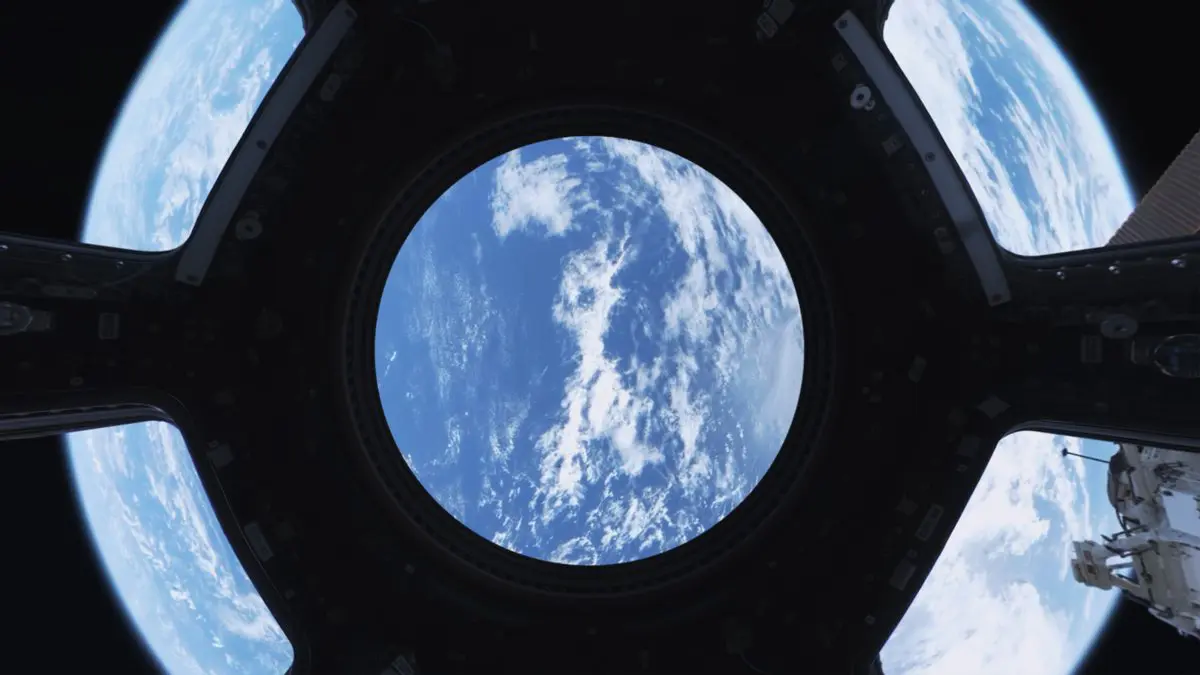
Space Explorers: The ISS Experience Episode 2: Advance — Noah’s Notes
Since the beginning of the modern VR age the name “Felix & Paul” has been synonymous with high end VR filmmaking. The eponymous Montreal-based studio formed by Félix Lajeunesse and Paul Raphaël have long been at the vanguard of the form.
There was a lot of heat on 360 film in the first phase of the current VR wave, in large part because of the limitations of the kinds of headsets that were readily available. 360 film has cooled somewhat, but those who still work the form have honed their craft immensely.
Of course, it helps when you’re able to shoot a documentary in outer space.
Advance is the second episode in a series set on the International Space Station, and while the format means you won’t go exploring in your own, the unprecedented access means that you’ll see things from a perspective heretofore unavailable to us ground pounders.
While there isn’t a lot of narrative frisson in this glimpse into the daily lives of four of the ISS’s astronauts, it’s still just incredible to be there and there are moments in the piece that moved me with the sense of how fragile life and our planet are. That shared experience of the totality of human existence that seems endemic to all those who have achieved orbit vibrates here in the background.
Where the piece really gets me is in the moments of watching the astronauts just doing mundane things like trying to run a power chord without getting tangled up, or making breakfast tacos. All the little details that are made strange by the lack of gravity in ways that no special effects artist would bother to render.
I could watch hours of a space cooking show filmed in the ISS. I’m just saying. NASA: this is how you deal with your budget issues. Diners, Drive-Ins, and Space Stations. Let’s get Guy Fieri in orbit.
But seriously: Felix & Paul can we have a b-roll bonus at the end of this series? Please? (3/16/21)
Kathryn’s Notes
Jeremy Bailenson, VR researcher and head of the Stanford Virtual Human Interaction Lab, often espouses that the best uses of VR are for experiences that are either dangerous, impossible, counterproductive, and/or expensive and rare. Thinking of this VR film shot inside the International Space Station and comparing it to, say, your average human being being able to travel up there (like you, I’m not an astronaut), I’d have to say that Space Explorers hits most of these marks (dangerous, counterproductive, and expensive). Add on Felix and Paul’s formidable VR filmmaking skills and you’ve got a surefire hit on your hands.
My only complaint is similar to Noah’s: just being in the environment in VR and watching the astronauts work, doing the most mundane of activities like getting a haircut or gardening, is such a joy. As a space nerd, the camera often seems to cut away too quickly much of the time to keep the momentum going. The experience of seeing the ISS like this is so novel that the runtime of 30-odd minutes truly feels like no time at all. So even with a bunch of other things on my plate during SXSW, I’m actually itching to hop back in and just look around the ISS on a second viewing. (3/18/21) — Kathryn Yu
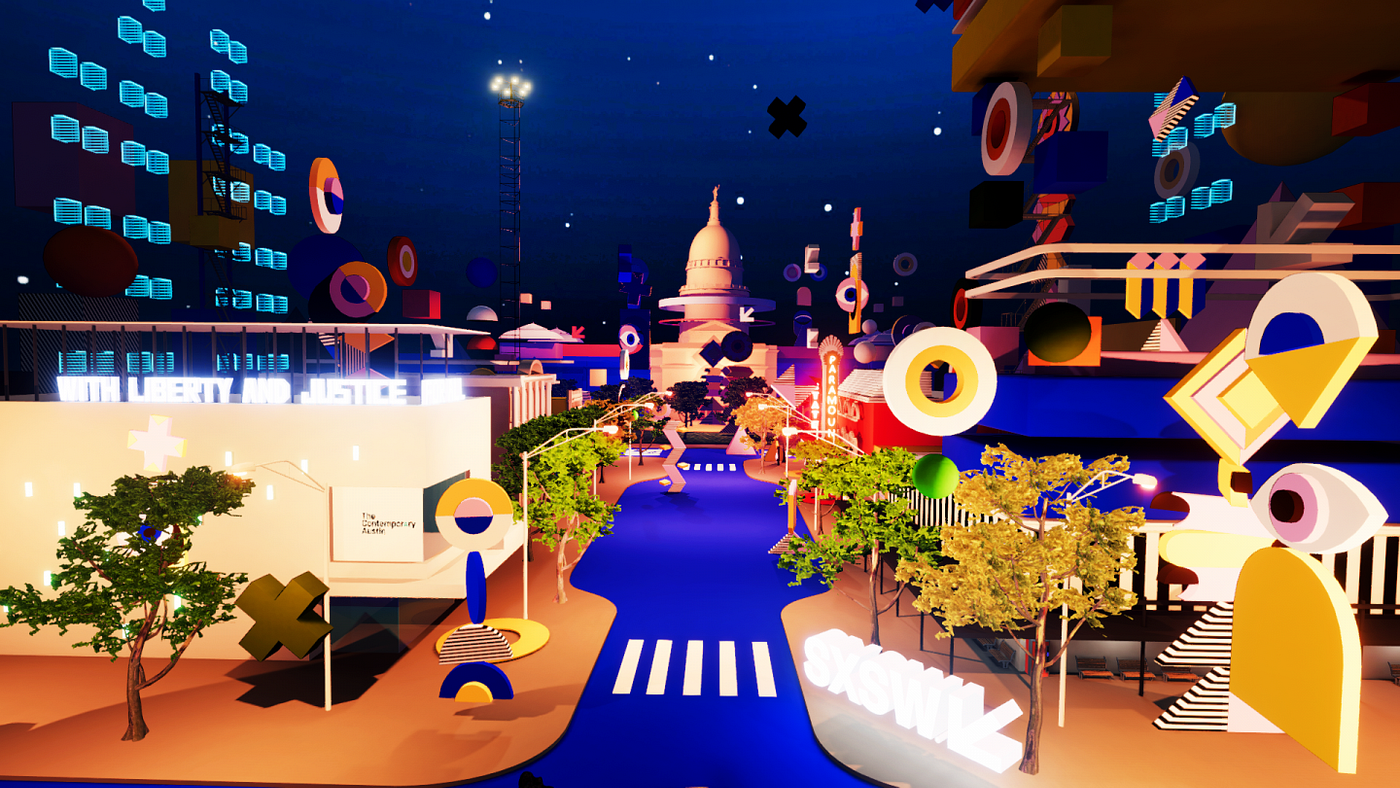
SXSW Online XR — Noah’s Notes
We’ve seen major cultural events like the Venice International Film Festival and Complexcon take a shot at creating virtual recreations of their event spaces with varying degrees of success. Some have emphasized the aesthetics, others the social dynamics of a festival environment. All of this over an array of platforms from browser based 2D interfaces to fully realized VR scenarios.
SXSW Online XR is one of the latter, produced by VRrOOm, the team that created the virtual space for Venice in VR Chat.
There’s no denying that what’s been built is GORGEOUS. This is what one imagines when one is told that “SXSW has a virtual festival.” There are recreations — inside and out — of iconic venues that instantly capture the vibe. Multiple streets — Congress, Red River — and multiple spaces — the Paramount, Empire Garage, the Contemporary — all have their digital doppelgängers.
On the street the aesthetic is somewhat cartoony: Austin as imagined by Fortnite-playing Imagineers with a deep love of It’s A Small World geometric whimsy. Fire rise up the sides of invisible buildings stretching into the sky as deconstructed animated obelisks compete with presentation domes and the Texas Capitol building for dominance of the skyline. Selfie stations are parked in iconic spaces so that you can prove that you were there, just like in the real world. Only the place you are is nothing like the real world, it’s better.
Instead of a fleet of Bird scooters littering every square inch, personal drones await you at the spawning point. Grab one to go careening over the streets. Or hop into a go cart and become a menace to pedestrians. Well, if you can get it to go. I swear that VRChat doesn’t like the Touch controllers bundled with the Oculus Quest 2. (And don’t get me started on the current headphone issues with the Link cable. Don’t. Even. Talk. To. Me. About. It.)
Step inside a venue and the verisimilitude jumps up a few notches. There, on the wall, is the calendar of events for that space. Just like it would be IRL. Interactive surprises are tucked away here and there — I think I even found a Myst like puzzle bit. The sense that I was somewhere, a place that I would love socializing with friends at while a holographic tuba artist played, was incredibly strong.
What was missing, at least at the press preview hour on Tuesday, was any sense of order to the audio. Maybe it was something with my personal settings — although I don’t think it was — but the spatial audio in the multi-story venues was a mess.
Inside the Contemporary it was possible to eavesdrop on conversations from the floor above or below where the speakers were talking. The problem with this, especially in a festival environment where the propensity to accidentally talk some harsh truths (to put it more politely than it deserves, perhaps), is glaringly obvious. I at first wondered if this was a limitation of VRChat, but a conversation with one of the more active creatives on the platform assured me that it is possible to keep that from happening, even if it’s not a super straightforward feature to implement.
It’s more than a tad frustrating, I have to say, as everything looks great. But there’s no point in “heading upstairs to get away from the crowd” if the crowd just follows you along as if it were a Clubhouse room you can’t escape.
Maybe this will get fixed before the week is through. I’d hope so. Aside from this issue, which sadly isn’t small, this is the best of these kinds of things I’ve been to so far and suggests that if VRChat were to add in some venue and event ticketing options they just might have a real solution for virtual and hybrid venues on their hands in the near future. (3/16/21)
Discover the latest immersive events, festivals, workshops, and more at our new site EVERYTHING IMMERSIVE, new home of NoPro’s show listings.
NoPro is a labor of love made possible by our generous Patreon backers. Join them today!
In addition to the No Proscenium web site, our podcast, and our newsletters, you can find NoPro on Twitter, Facebook, YouTube, Instagram, in the Facebook community Everything Immersive, and on our Discord.








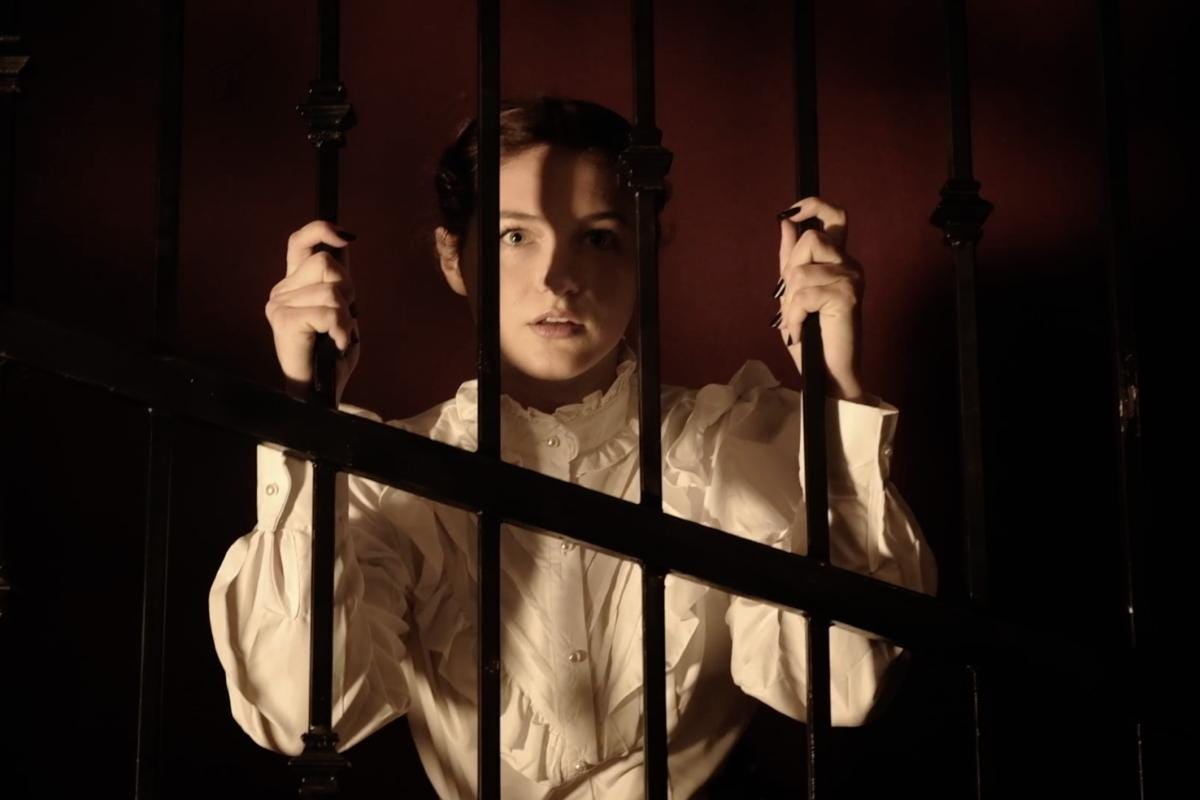





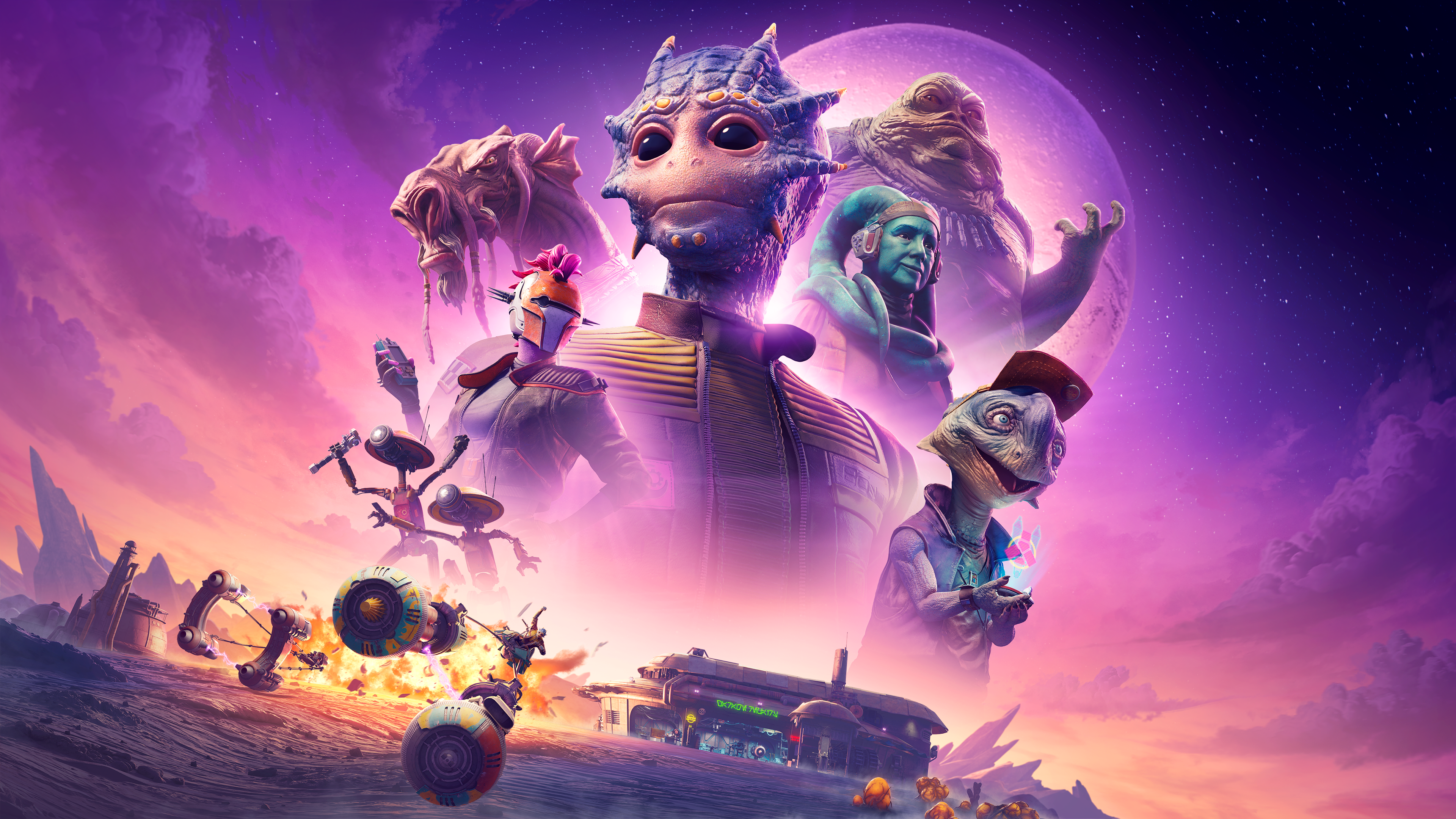
Discussion